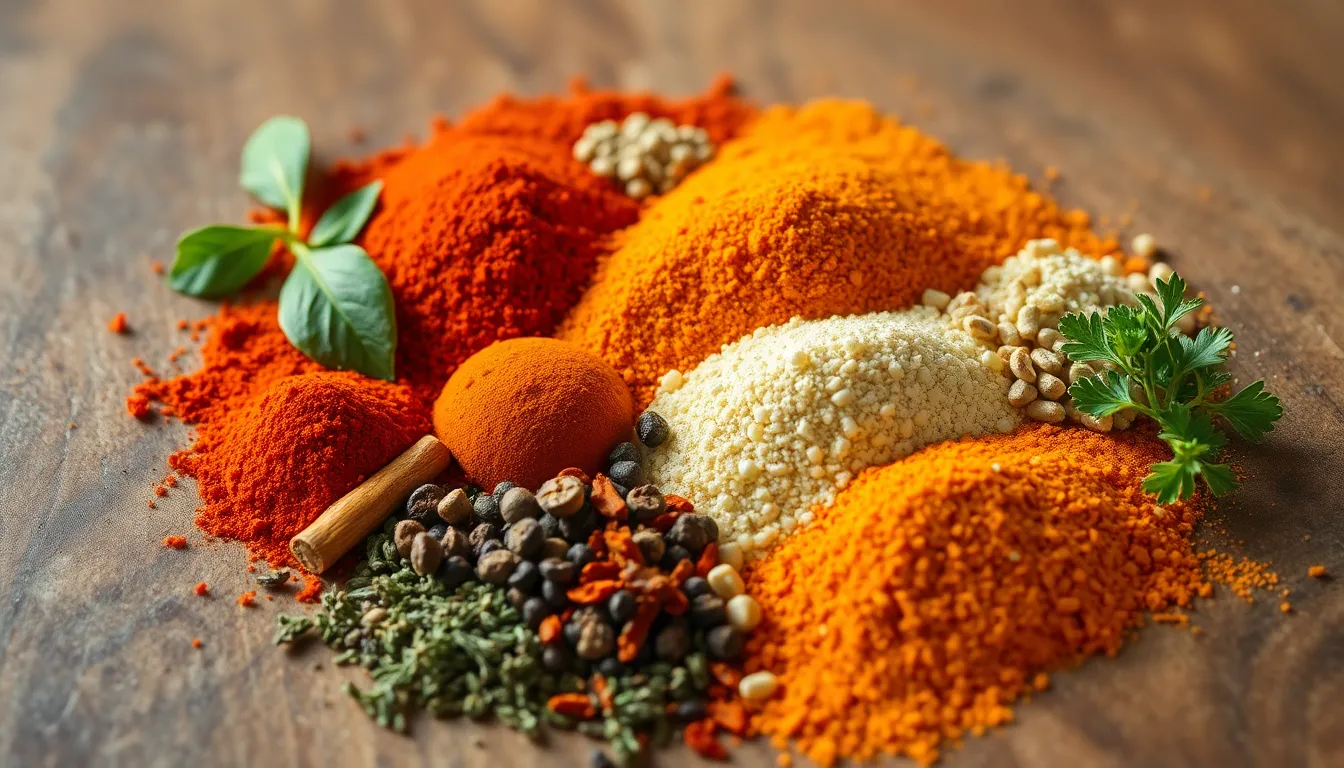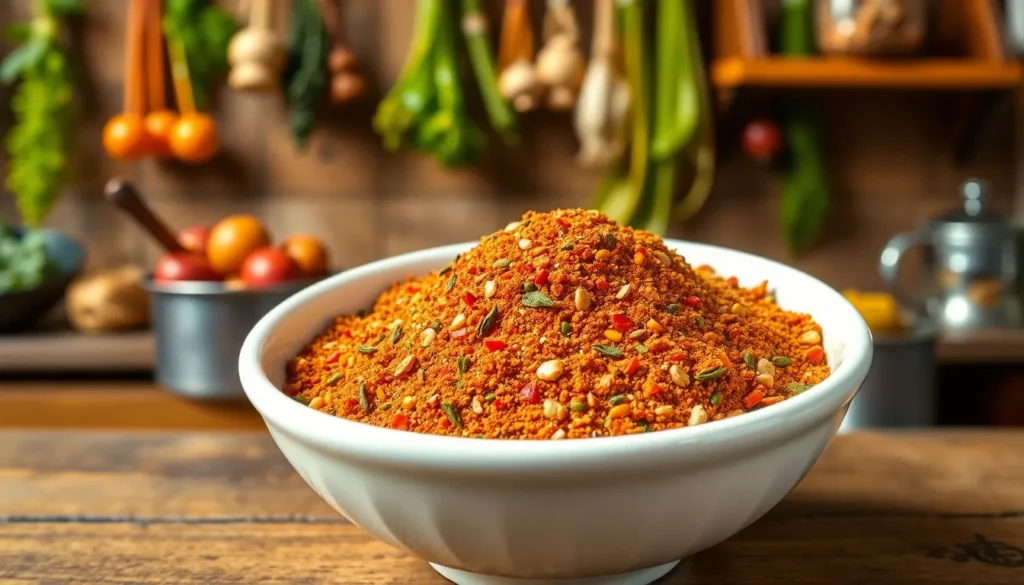Table of Contents
ToggleCreole seasoning is like a party in a jar that your taste buds can’t resist. Originating from the vibrant cultures of Louisiana, this spice blend brings the heat and flavor that can transform any dish from drab to fab. If you think your cooking needs a little pizzazz, just wait until you sprinkle some of this magic dust on your next meal.
Overview of Creole Seasoning
Creole seasoning is a distinctive spice blend rooted in Louisiana’s culinary traditions. This seasoning typically consists of a variety of spices that add depth and flavor to diverse dishes. Common ingredients include paprika, garlic powder, onion powder, cayenne pepper, black pepper, and dried herbs like oregano and thyme. The combination of these elements creates a robust flavor profile great for enhancing meats, seafood, and vegetable dishes.
Paprika provides sweetness and color, while garlic and onion powders deliver savory undertones. Cayenne pepper introduces a zesty heat that elevates the overall taste. Each component plays a critical role in balancing flavors, making Creole seasoning versatile enough for multiple cuisines.
Creole seasoning varies slightly among chefs and cultures, with some opting for additional herbs or spices. For instance, some recipes might include bay leaves or celery salt to deepen the flavor complexity. This flexibility allows it to cater to individual palates, adapting to different culinary styles while maintaining its core characteristics.
Using Creole seasoning adds a signature taste and brings together various flavors seamlessly. Many home cooks and professional chefs appreciate its ability to transform simple dishes into memorable meals. It’s also a staple in Cajun cuisine, showcasing its cultural significance and culinary heritage.
Creole seasoning encapsulates the essence of Louisiana’s delicious food landscape, marrying flavors that enhance both traditional and contemporary recipes alike.
Common Ingredients in Creole Seasoning

Creole seasoning features a blend of various ingredients that contribute to its distinctive flavor. The mix primarily consists of a combination of spices and herbs.
Herbs and Spices
Paprika serves as a base spice, adding sweetness and vibrant color. Garlic powder brings depth and savory notes, while onion powder enhances the overall flavor profile. Cayenne pepper provides heat, balancing the other components. Black pepper contributes a subtle spiciness, rounding out the blend. Dried oregano and thyme introduce earthy undertones, enriching various dishes. Each of these elements plays a crucial role in creating a robust seasoning that can enhance meats, seafood, and vegetables.
Salt and Other Flavor Enhancers
Salt acts as a key component in Creole seasoning, accentuating the flavors of the other ingredients. Some blends may include celery salt or onion salt for added complexity. Other flavor enhancers can include sugar for a touch of sweetness or lemon zest for brightness. By incorporating these elements, Creole seasoning becomes a versatile blend, enhancing both traditional and contemporary recipes. These additions not only deepen taste but also elevate the overall culinary experience in dishes.
Variations of Creole Seasoning
Creole seasoning showcases diverse variations that highlight regional preferences and available ingredients.
Regional Differences
Regional interpretations of Creole seasoning often emphasize local flavors. In New Orleans, for instance, chefs might incorporate a stronger focus on seafood with the addition of herbs like bay leaf and parsley. Other regions may prefer a sweeter profile by adding ingredients such as cinnamon or nutmeg. Specific combinations can vary based on cultural influences, with some garam masala elements seen in Caribbean versions. Different spices reflect unique culinary traditions, showcasing how Creole seasoning adapts to local tastes.
Homemade vs. Store-Bought
Homemade Creole seasoning offers the advantage of customization. By combining fresh spices, individuals can adjust flavors to their liking, adding more heat or sweetness as desired. Store-bought options provide convenience, often formulated for consistency. Pre-packaged varieties typically include standard ingredients like paprika and garlic powder but may lack the freshness of homemade blends. Homemade versions often result in richer flavors, while store-bought mixes deliver ease of use for quick preparations. Each choice has benefits based on personal cooking habits and preferences.
Uses of Creole Seasoning in Cooking
Creole seasoning enhances various dishes, providing rich flavors that reflect Louisiana’s culinary heritage. Home cooks often sprinkle it on meats for grilling or roasting. Grilled chicken benefits from a generous coating, yielding a spicy, flavorful crust. Chefs use it in seafood recipes, elevating shrimp, fish, or crab with a kick of zesty heat.
Soups and stews gain depth when Creole seasoning is included. Gumbo showcases its versatility, with aromatics melding beautifully with this spice blend. Red beans and rice become more exciting as the seasoning infuses every bite with flavor.
Vegetables also respond well to Creole seasoning. Roasted vegetables like bell peppers, zucchini, and potatoes gain a new dimension, appealing to those seeking vibrant, tasty meals. Salads become more robust; a sprinkle can transform a simple dish into something special.
Equally important is the use of Creole seasoning in marinades. It melds well with oil and vinegar, creating a flavorful base for meats and vegetables. In this way, together with a little time, the seasoning penetrates and enhances each ingredient.
Creative uses extend beyond traditional applications. Chefs blend it into sauces, dressings, and even dips for an unexpected flavor boost. It’s a favorite in Cajun dishes, but its adaptability suits numerous cuisines.
With so many applications, Creole seasoning proves itself an indispensable tool in the kitchen. Whether enhancing classic recipes or experimenting with new ones, it brings joy to the cooking experience.
Creole seasoning stands out as a vibrant and essential component in the culinary world. Its unique blend of spices not only enhances the flavors of various dishes but also reflects the rich cultural tapestry of Louisiana. Whether used in traditional recipes or modern creations, this seasoning brings a delightful kick that transforms meals into memorable experiences.
Home cooks and professional chefs alike appreciate its versatility and ability to elevate everything from meats to vegetables. With the option to customize homemade blends or rely on convenient store-bought varieties, Creole seasoning remains a beloved staple in kitchens everywhere. Embracing this flavorful blend opens the door to endless culinary possibilities, making every dish a celebration of taste.







